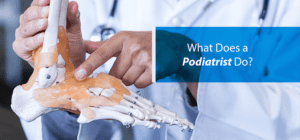
What Does A Podiatrist Do?
We often don’t think about our feet until they start causing us pain. Of course, your feet and ankles serve a crucial role in everyday functioning. After all, your feet help you get to where you need to go. They absorb the shock of your body’s movements. From walking up a flight of stairs to running a marathon, your feet make it all possible. So what happens when you start experiencing foot pain? Sometimes taking it easy for a few days and elevating your feet may make the pain go away. Other times you need the help from an experienced doctor who specializes in foot and ankle conditions. Many people turn to a podiatrist when they begin to experience problems with their feet. But what is a podiatrist? And, what kinds of foot conditions does a podiatrist treat? Use this guide to learn more about this valued health professional. What is a Podiatrist? Sometimes known as a doctor of podiatric medicine (DPM), these individuals use conservative treatments, as well as foot and ankle surgery, to treat those who struggle with foot problems. In fact, podiatrists undergo the same extensive medical training as other doctors. In addition to completing medical school, a podiatrist also performs four years at a podiatric medical school and three years in residency training. Some podiatrists specialize in fields like sports medicine, diabetic foot care, or foot and ankle surgery. All of this training and practice means that you’ll have an experienced professional to prevent, diagnose, and treat many types of foot disorders. What Conditions Does a Podiatrist Treat? Your feet go through a lot of abuse every day. Think of all the steps that you take each day. Maybe you’re even one of those people who tracks your steps to stay fit. Of course, all of this movement affects your feet. Instead of confidently stepping forward, each new step may be a painful reminder of a foot or ankle condition. A podiatrist can help you get back to achieving your daily step count without constant discomfort. Podiatrists can help with: Ankle Fractures or Sprains: Ankle fractures and sprains often occur when we step the wrong way during athletic activities or walking. A podiatrist can accurately diagnose these conditions and provide proper treatment. Ingrown toenails: This occurs when the corner of a toenail grows into the surrounding soft tissue. In severe cases involving inflammation, pain, and pus, a podiatrist can help by removing the ingrown portion of the nail. Plantar fasciitis: Occurs when your plantar fascia—a band of tissue at the bottom of your foot—becomes inflamed. Age, obesity, and certain exercises can be to blame. A podiatrist can diagnose this condition and treat it using injections, orthotics, or even surgery. Plantar warts: These are small growths on the heel or other parts of the foot caused by the HPV virus. This virus thrives in warm, damp environments like locker rooms and swimming pools. Plantar warts may go away on their own, but, in more serious conditions, a



